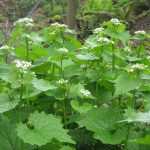Garlic Mustard
Identification:
Garlic Mustard has triangular, heart-shaped leaves with toothed edges and white four-petal flowers. During its first year, garlic mustard leaves are rounder and take on a rosette formation at ground level. In their second year, the leaves grow up a flowering stem and become more triangular and heart-shaped with toothed edges. Small white four-petaled flowers emerge in the spring, making this the easiest time to identify the plant.
Garlic mustard is a threat to the biodiversity of many native ecosystems. This plant spreads its seeds in the wind and gains a foothold in fields and forests by emerging earlier in spring than many native plants. By the time native species are ready to grow, garlic mustard has blocked their sunlight and outcompeted them for moisture and vital nutrients. Additionally, garlic mustard’s roots release chemicals that alter the important underground network of fungi that connect nutrients between native plants, inhibiting the growth of important species like trees, and promoting the growth of more garlic mustard.
For more information, please see our Garlic Mustard brochure.
Control:
Hand removal of plants is possible for light infestations and where native species co-occur with it. When the soil is moist, firmly grasp the plant low and tug gently until the main root loosens from the soil and the entire plant pulls out. Remove the plant with its entire root system or new plants may sprout from root fragments. Take care not spread any plants that have gone to seed. Remove completely from the site and dispose of in garbage bags or schedule a drop off at the Department of Public works office by emailing concom@sudbury.ma.us.


